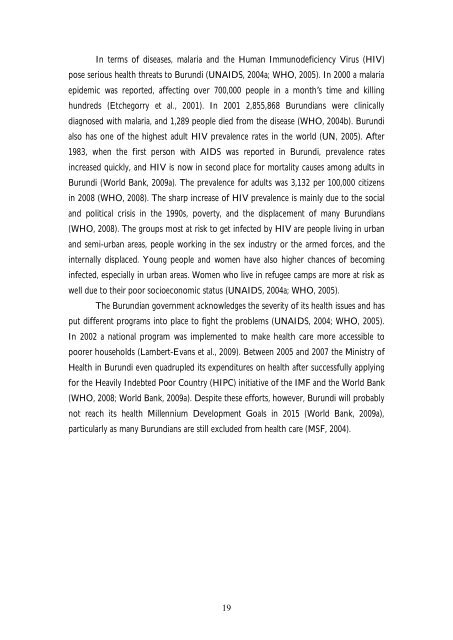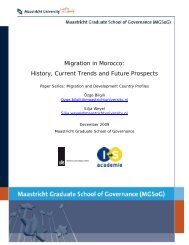Migration in Burundi: History, Current Trends and Future - MGSoG ...
Migration in Burundi: History, Current Trends and Future - MGSoG ...
Migration in Burundi: History, Current Trends and Future - MGSoG ...
Create successful ePaper yourself
Turn your PDF publications into a flip-book with our unique Google optimized e-Paper software.
In terms of diseases, malaria <strong>and</strong> the Human Immunodeficiency Virus (HIV)<br />
pose serious health threats to <strong>Burundi</strong> (UNAIDS, 2004a; WHO, 2005). In 2000 a malaria<br />
epidemic was reported, affect<strong>in</strong>g over 700,000 people <strong>in</strong> a month’s time <strong>and</strong> kill<strong>in</strong>g<br />
hundreds (Etchegorry et al., 2001). In 2001 2,855,868 <strong>Burundi</strong>ans were cl<strong>in</strong>ically<br />
diagnosed with malaria, <strong>and</strong> 1,289 people died from the disease (WHO, 2004b). <strong>Burundi</strong><br />
also has one of the highest adult HIV prevalence rates <strong>in</strong> the world (UN, 2005). After<br />
1983, when the first person with AIDS was reported <strong>in</strong> <strong>Burundi</strong>, prevalence rates<br />
<strong>in</strong>creased quickly, <strong>and</strong> HIV is now <strong>in</strong> second place for mortality causes among adults <strong>in</strong><br />
<strong>Burundi</strong> (World Bank, 2009a). The prevalence for adults was 3,132 per 100,000 citizens<br />
<strong>in</strong> 2008 (WHO, 2008). The sharp <strong>in</strong>crease of HIV prevalence is ma<strong>in</strong>ly due to the social<br />
<strong>and</strong> political crisis <strong>in</strong> the 1990s, poverty, <strong>and</strong> the displacement of many <strong>Burundi</strong>ans<br />
(WHO, 2008). The groups most at risk to get <strong>in</strong>fected by HIV are people liv<strong>in</strong>g <strong>in</strong> urban<br />
<strong>and</strong> semi-urban areas, people work<strong>in</strong>g <strong>in</strong> the sex <strong>in</strong>dustry or the armed forces, <strong>and</strong> the<br />
<strong>in</strong>ternally displaced. Young people <strong>and</strong> women have also higher chances of becom<strong>in</strong>g<br />
<strong>in</strong>fected, especially <strong>in</strong> urban areas. Women who live <strong>in</strong> refugee camps are more at risk as<br />
well due to their poor socioeconomic status (UNAIDS, 2004a; WHO, 2005).<br />
The <strong>Burundi</strong>an government acknowledges the severity of its health issues <strong>and</strong> has<br />
put different programs <strong>in</strong>to place to fight the problems (UNAIDS, 2004; WHO, 2005).<br />
In 2002 a national program was implemented to make health care more accessible to<br />
poorer households (Lambert-Evans et al., 2009). Between 2005 <strong>and</strong> 2007 the M<strong>in</strong>istry of<br />
Health <strong>in</strong> <strong>Burundi</strong> even quadrupled its expenditures on health after successfully apply<strong>in</strong>g<br />
for the Heavily Indebted Poor Country (HIPC) <strong>in</strong>itiative of the IMF <strong>and</strong> the World Bank<br />
(WHO, 2008; World Bank, 2009a). Despite these efforts, however, <strong>Burundi</strong> will probably<br />
not reach its health Millennium Development Goals <strong>in</strong> 2015 (World Bank, 2009a),<br />
particularly as many <strong>Burundi</strong>ans are still excluded from health care (MSF, 2004).<br />
19



